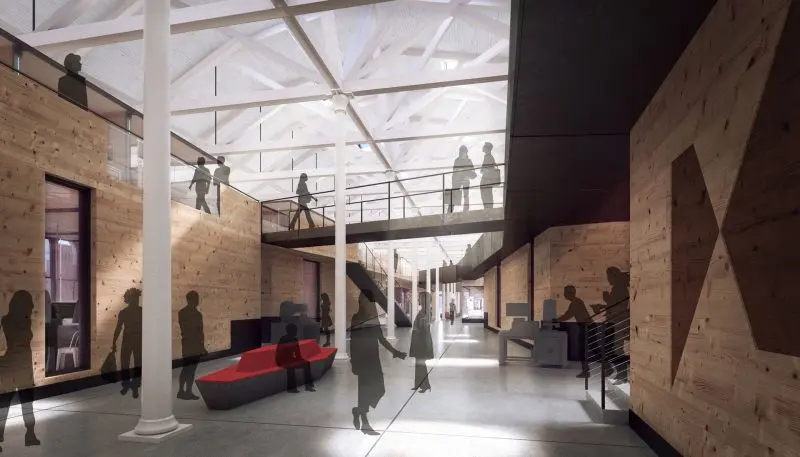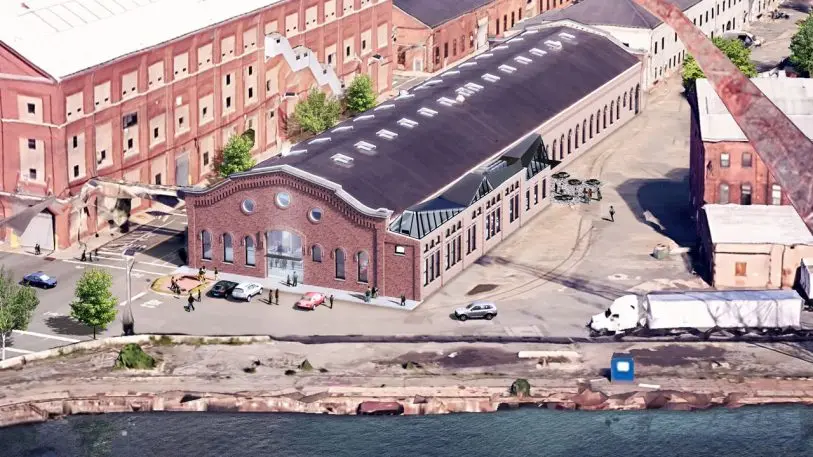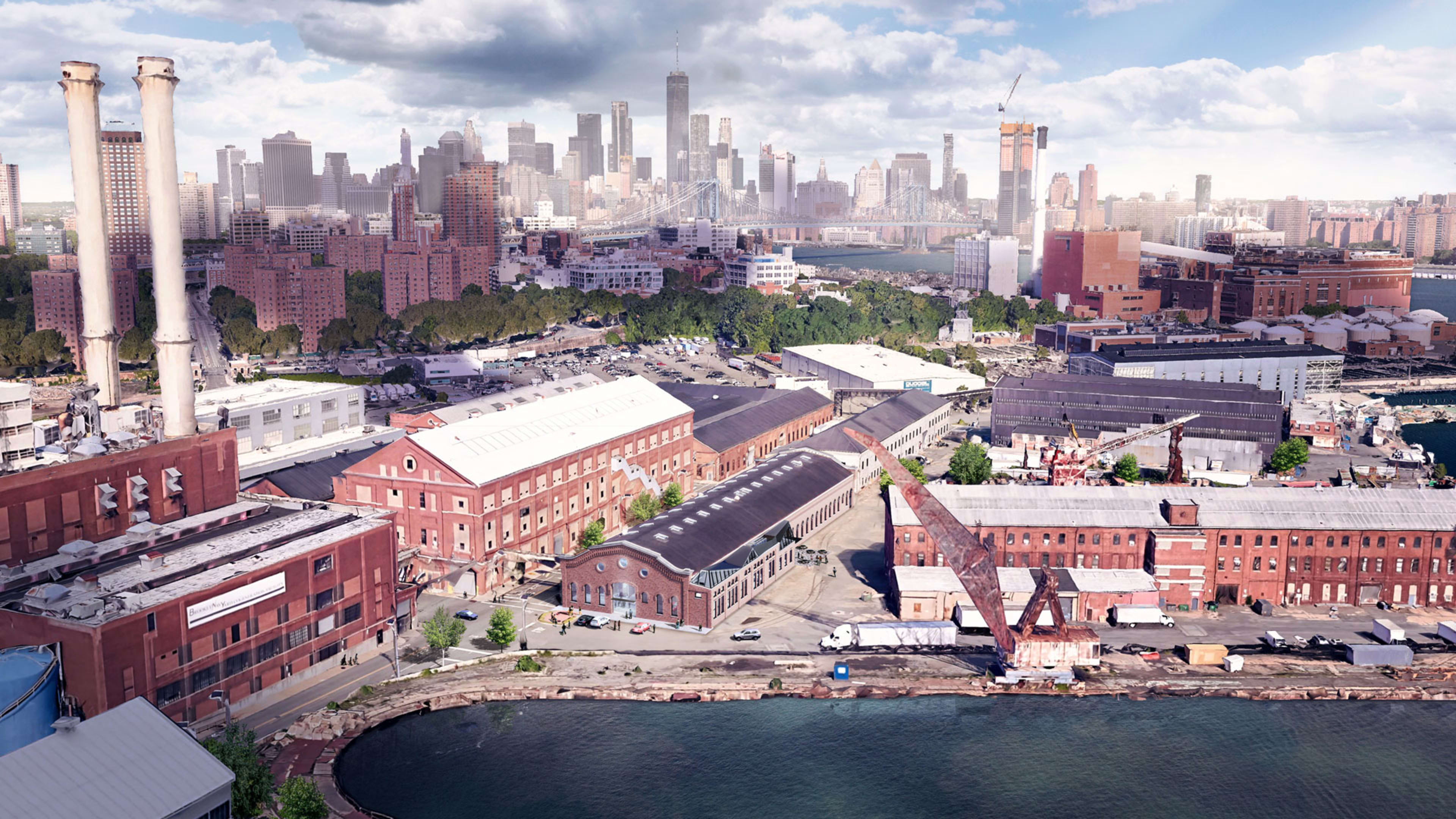At an 80,000-square-foot combat gear factory in Brooklyn’s Navy Yard, there is only the quiet chatter of sewing needles and the distinct absence of sweat. A thick stack of fabric lies on a long machine waiting to be compressed and cut into shapes. “It can automate a lot,” says Gregg Thompson cofounder of combat wear company Crye Precision, “but the volume has to be there.” Machines are not so great at design iteration, he says. A man standing next to the machine slices sheets of fabric by hand. He’s faster, says Thompson, and he can execute multiple designs without needing to be reprogrammed.
A shift is happening in manufacturing, bringing humans and machines closer together and making production more responsive to changing needs. The change is coming from companies that need flexible processes that allow their products to evolve with the needs of their customers. They also want their facilities not in industrial suburbs, but in amenity rich neighborhoods, so they can attract star talent. This new urban industrial wave is emerging in cities like Boston, Brussels, and New York City. The latest shift toward a rebirth of manufacturing is happening at Brooklyn’s Navy Yard, a converted ship-building site where a new kind of industry–less toxic, better paid, and offering upward mobility–is taking shape.

“You would be able to eat around our machines”
Crye Precision is one of the crowning manufacturing achievements of the Brooklyn Navy Yard Development Corporation, which is working to bring manufacturing jobs into a city with some of the highest rents in the country. The facility gleams. Inside the entrance is a still shrub and stone studded garden where workers practice Tai Chi. The long, big-windowed cafeteria where workers commune for lunch everyday is clean and sunlit. On the opposite side is a yet-to-be-developed showroom where customers can actually touch the products being developed there. The bottom floor along the sides of the building holds sewing and assembly rooms. On the top floor are offices, extra sewing facilities, sales, and product review areas. In the large middle is storage and product boxed up and waiting to be shipped.
Right now, the Navy Yard, a 300-acre campus strung along the East River, supplies New Yorkers with 9,500 jobs. In the next few years, it is poised to deliver another 11,000, a quarter of which will be manufacturing. Ideally, BNYDC wants to be able to support 30,000 workers there. The jobs will be a mix of higher paid office jobs, as well as film production and manufacturing roles. “There is talk about the loss of manufacturing… and not a lot of real thinking or policy work around acknowledging that the manufacturing that’s left probably is not truly coming back,” says David Ehrenberg, president and CEO of BNYDC. “We’re not trying to hearken back to the Navy Yard of the 1950s when we were building warships.”
BNYDC’s grand vision is to create a campus that seamlessly integrates small and medium manufacturing operations with white collar offices, production studios, restaurants, coffee roasteries and shops, distilleries, grocery stores, bakeries, and rooftop gardens with edible greens. Tenants include WeWork, Steiner Studios, Russ and Daughters bakery, Brooklyn Grange farms, and grocer Wegman’s. It is an ambitious project that relies on building up rather than out and, because of its proximity to residents, keeping the manufacturing clean.
Founded in 2010, Nanotronics is a nanotechnology company that develops an array of hardware and software products that combine microscopic imaging and artificial intelligence–essentially, extremely advanced microscopes. The company currently has offices at the Navy Yard and Ohio, as well as a manufacturing site in California. This year it will expand its New York footprint into a new building in the Navy Yard that will serve as corporate headquarters, research and development, future product design, and manufacturing facility.
“You would be able to eat around our machines,” says Matthew Putman, chief executive and founder of Nanotronics. His company is currently tweaking designs for the new 34,000-square-foot facility. Putman says it will bear no resemblance to the hard worn image heavy manufacturing has emblazoned in the collective mind. There will be no toxic chemicals, no oil on the floor: Research and development, mechanical engineers, physicists, tradespeople, and the marketing office will all work side by side in one space.
A facility like this will mean much faster operations and a closer connection to the product. The workflow will look something like this: a customer will call and ask for something, a designer will mock up a solution in its upstairs offices, that drawing will travel downstairs to production, once the part is made it will fly under the purview of a solutions architect who will vet whether the product actually suits the described need. Essentially, the company can iterate on customer needs much faster–in a single day. Previously, the company would have had to send parts back and forth between its manufacturing facility in Los Angeles and main headquarters in New York, a process that takes days if not weeks.
Nanotronics plans to hire roughly 200 employees and will have an apprenticeship program to help get workers up to speed on its technological infrastructure.
“I used to say that it’s not the next great social network that should be invented in a dorm room, it’s the next factory” said Putman.
A reckoning–and a resurgence–for manufacturing
Manufacturing’s contribution to the overall makeup of U.S. employment has been shrinking since the end of World War II, when it represented nearly 40% of nonfarm U.S. jobs. As of January 2019, manufacturing only represented 8% of U.S. employment. Despite its diminishing contribution to the economy, the number of manufacturing jobs on offer were actually growing up until the late 1970s. The doldrums hit when automation started to replace workers and rising labor costs drove some brands to manufacture overseas into China. Auto worker layoffs during the 2008 recession further stoked jobs downward.
But more recently, the trend has reversed. Since 2010 manufacturing jobs have been steadily on the rise, according to the Bureau of Labor Statistics. The majority of that comes from the booming U.S. oil industry. However, a small but important segment of growth is happening in and near cities. A new class of brands are shaking up the supply chain and finding innovative ways to manufacture close to their customers.
They come as the cost savings of manufacturing overseas has dwindled. Transporting products in from other countries is expensive and time intensive. And as Amazon’s fast shipping has shown, speed is everything. In addition to figuring out how to get product to customers faster, new brands also grapple with how to make their products more unique or personalized.
This has led to a small movement that’s bringing manufacturing back to the states. It often means finding an affordable space near a big city with a smaller footprint, which also means strategically investing in technology–sometimes designing their own.
Chobani’s high-tech, 50,000 square foot plant in Twin Falls, Idaho, resembles a “high-end suburban shopping mall.” In Atlanta, Adidas’s robot-powered Speedfactory is automating the shoemaking process. And Shinola has made a name for itself by focusing its branding on its Detroit-based manufacturing. Factory workers are no longer just doing mindless production line work. The new manufacturing requires interacting with complicated robots and fixing computer systems. “The manufacturing is smaller and cleaner and more sustainable and doesn’t pollute as much,” says Nina Rappaport, author of Vertical Urban Factory. What’s more, these mini-manufacturing operations can be stacked, one on top of the other inside of multi-floor buildings. Buildings can be shared among a few companies rather than devoted to a single one.

The new industrial jobs
At the Navy Yard there are a range of positions. “You can go from packing the boxes to running one of the machines to repairing the machine to being the night manager to being the day manager to running the line on this specific machine,” says David Ehrenberg at BNYDC. But he also thinks the old days when you can just show up to factory without an education or skills and expect work are gone, “Just creating the jobs isn’t enough,” he says.
BNYDC works with local elementary, middle, high schools, and colleges to offer job training and ensure the jobs coming to the Navy Yard are accessible to people who live in the area. “If they need more skills then we’re upskilling them to make sure that they’re prepared for the next generation of jobs,” he says. The Navy Yard also recently opened its own high school on campus called the Brooklyn Science Technology Engineering Arts and Mathematics Center (The STEAM Center for short). The school, developed in partnership with the Department of Education, gives qualifying junior and senior high school students from eight area schools the opportunity to spend half their day learning curriculum influenced by the equipment, jobs, and working cultures on display at the Navy Yard.
The school also plans to offer training for adults. “Written into the lease is the right for us to use that space to do incumbent training for adults,” says Ehrenberg.
Barry Jaruzelski, senior partner at consulting firm Strategy&, says that companies are finding that they also have to invest in training. “Right now the labor market is so tight, companies are increasing their training programs because it is so hard to get people,” he says. “Five or six years ago you had your pick–now you don’t.”
Ironically, he says, the move towards training manufacturing employees is a return to a practice that was once common in the 1950s and 1960s. Still he says, much of the new manufacturing is still early days and there are not a lot of these kinds of jobs just yet.
Back at the Navy Yard, Matthew Putman surveys the inside of a cavernous factory that will soon house Nanotronics office and manufacturing. “It’s the oldest building,” he says marveling at the legacy, “I guess they made submarines in here, the very first ones. Turn of the century.”
The company is planning to install a criss-crossing mezzanine in the space, intended to create opportunities for workers from different departments to run into each other and exchange ideas. Putman says business offices will be upstairs and downstairs alongside clean rooms and manufacturing setups. “It’s part of mixing things up and making sure everything’s integrated,” he says.
It’s a notion that has its roots in Bell Labs’s famous campus, part of the last era of manufacturers, from a very different time than this new wave of industry. Lawmakers have been fighting to keep manufacturing in the New York economy for a long time, but have had little success. Perhaps no one thought it was coming back?
“I would have never thought 10 years ago that we would be building this here,” said Putman.
Correction: A previous version of this article misspelled the name of Nanotronics CEO Matthew Putman. It has also been updated to note the correct location of Chobani’s factory.
Recognize your brand’s excellence by applying to this year’s Brands That Matter Awards before the early-rate deadline, May 3.
